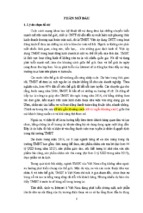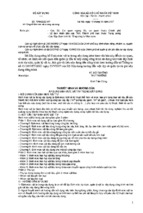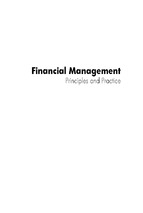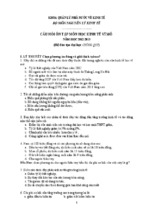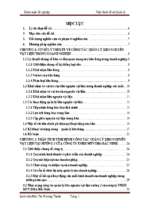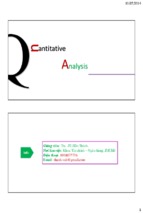Financial Management
Principles and Practice
Financial Management
Principles and Practice
Sixth Edition
Timothy J. Gallagher
Professor of Finance
Colorado State University
FINANCIAL MANAGEMENT: PRINCIPLES AND PRACTICE, 6th Edition
Copyright 2013, 2010 by Timothy Gallagher. Published by Freeload Press
Copyright 2007 by Gallagher and Andrew. Published by Freeload Press
Previous editions © 2003, 2000, and 1997 by Pearson Education, Inc.
All rights reserved. Printed in the United States of America. No part of this book may be reproduced
or transmitted in any form or by any means, electronic or mechanical, including photocopying and
recording, or by any information storage or retrieval system without the prior written permission
of the authors.
ISBN 1-930789-15-7
Library of Congress Cataloging-in-Publication Data
Gallagher, Timothy James, 1952–
Financial Management: Principles and Practice/Timothy J. Gallagher— 6th ed.
p. cm.
Includes bibliographical references and index.
1. Corporation—Finance. I. Andrew, Joseph D. II. Title
HG4026. G348 2006
658.15—dc21
2002074888
This book was previously published by: Pearson Education, Inc.
To my family—
my parents, Bob and Lois
my wife, Susan
and Em, Justin, Ellie, and Zach
Preface xix
About the Author xxvii
PART I � THE WORLD OF FINANCE 1
PART IV � �LONG-TERM FINANCING
DECISIONS 381
1 � Finance and the Firm 2
13 � Capital Structure Basics 382
2 � Financial Markets and Interest Rates 24
14 ��Corporate Bonds, Preferred Stock,
and Leasing 414
3 � Financial Institutions 44
15 � Common Stock 440
PART II � �ESSENTIAL CONCEPTS
IN FINANCE 65
16 � Dividend Policy 464
4 � Review of Accounting 66
PART V � �SHORT-TERM FINANCING
DECISIONS 485
5 � Analysis of Financial Statements 92
17 � Working Capital Policy 486
6 � Forecasting for Financial Planning 134
18 � Managing Cash 508
7 � Risk and Return 160
19 � Accounts Receivable and Inventory 534
8 � The Time Value of Money 194
20 � Short-Term Financing 568
PART III � �CAPITAL BUDGETING AND
BUSINESS VALUATION 237
PART VI � �FINANCE IN THE GLOBAL
ECONOMY 593
9 � The Cost of Capital 238
21 � International Finance 594
10 � Capital Budgeting Decision Methods 270
Appendix A-1
11 � Estimating Incremental Cash Flows 314
Glossary G-1
12 � Business Valuation 338
Index I-1
vii
Preface xix
About the Author xxvii
PART I � THE WORLD OF FINANCE 1
2 � Financial Markets and Interest Rates 24
1 � Finance and the Firm 2
Learning Objectives 25
Chapter Overview 25
The Financial System 25
Learning Objectives 3
Chapter Overview 5
The Field of Finance 5
Securities 26
Financial Intermediaries 26
Investmen Bankers 26
Brokers 27
Dealers 27
Finance Career Paths 6
Financial Management 6
The Role of the Financial Manager 6
Finance in the Organization of the Firm 6
The Organization of the Finance Team 7
Financial Markets 27
The Basic Financial Goal of the Firm 7
The Primary Market 27
The Secondary Market 27
The Money Market 28
The Capital Market 28
Security Exchanges 28
The Over-the-Counter (OTC) Market 28
Market Efficiency 29
In Search of Value 8
The Importance of Cash Flow 9
The Effect of Timing on Cash Flows 10
The Influence of Risk 10
Profits versus Company Value 11
Legal and Ethical Challenges in Financial
Management 11
Securities in the Financial Marketplace 29
Agency Issues 11
The Agency Problem 12
Agency Costs 13
The Interests of Other Groups 13
The Interests of Society as a Whole 14
Securities in the Money Market 29
Treasury Bills 29
Negotiable Certificates of Deposit 30
Commercial Paper 30
Banker’s Acceptances 30
Securities in the Capital Market 30
Bonds 30
Bond Terminology and Types 31
Treasury Notes and Bonds 31
Municipal Bonds 32
Corporate Bonds 32
Corporate Stock 32
Common Stock 32
Preferred Stock 33
Forms of Business Organization 14
The Proprietorship 14
The Partnership 15
Special Kinds of Partnerships 16
The Corporation 16
Special Kinds of Corporations 17
Limited Liability Companies (LLCs) 18
What’s Next 18
Summary 18 • Self‑Test 20 • Review
Questions 20 • Build Your Communication
Skills 21 • Problems 21 • Answers to
Self‑Test 22
ix
x
Contents
Interest 33
Determinants of Interest Rates 33
The Real Rate of Interest 33
The Inflation Premium 34
The Default Risk Premium 35
The Illiquidity Risk Premium 35
The Maturity Risk Premium 35
The Yield Curve 36
Making Use of the Yield Curve 36
What’s Next 37
Summary 37 • Self‑Test 39 • Review
Questions 39 • Build Your Communication
Skills 40 • Problems 40 • Answers to
Self‑Test 42
3 � Financial Institutions 44
Learning Objectives 45
Chapter Overview 45
Financial Intermediation 45
Denomination Matching 46
Maturity Matching 46
Absorbing Credit Risk 47
Commercial Banks 47
Bank Regulation 47
Commercial Bank Operations 48
Commercial Bank Reserves 48
The Federal Reserve System 49
Organization of the Fed 49
Controlling the Money Supply 50
The Discount Window 52
Government Sponsored Enterprises
and the Mortgage Market (GSEs) 52
Savings and Loan Associations 53
Regulation of S&Ls 53
Mutual Companies versus Stockholder-Owned
Companies 53
The Problem of Matching Loan and Deposit
Maturities 54
S&Ls’ Real Assets 55
Credit Unions 55
The Common Bond Requirement 55
Members as Shareholders 55
Credit Unions Compared with Banks 56
Credit Union Regulation 56
Finance Companies, Insurance Companies,
and Pension Funds 56
Types of Finance Companies 56
Consumer Finance Companies 56
Commercial Finance Companies 56
Sales Finance Companies 56
Insurance Companies 56
Life Insurance Companies 57
Property and Casualty Insurance Companies 57
Pension Funds 58
Annuities 58
Legislation After the Financial Crisis 59
What’s Next 60
Summary 60 • Self‑Test 61 • Review
Questions 61 • Build Your Communication
Skills 62 • Problems 62 • Answers to
Self‑Test 63
PART II � �ESSENTIAL CONCEPTS
IN FINANCE 65
4 � Review of Accounting 66
Learning Objectives 67
Chapter Overview 67
Review of Accounting Fundamentals 67
Basic Accounting Financial Statements 68
The Income Statement 68
Revenues 69
Expenses 69
Cost of Goods Sold 69
Selling and Administrative Expenses 69
Depreciation Expense 70
Operating Income and Interest Expense 70
Net Income 70
Earnings per Share (EPS) 70
Common Stock Dividends and Retained Earnings 71
The Balance Sheet 72
The Asset Accounts 72
Current Assets 72
Fixed Assets 72
The Liabilities and Equity Accounts 73
Liabilities 73
Common Stock and Retained Earning 74
The Statement of Cash Flows 74
Operating Activities 74
Adjustment for Depreciation Expense 74
Changes in Balance Sheet Accounts 75
Operating Activities 76
Investment Activities 77
Financing Activities 77
Net Cash Flow during the Period 77
Depreciation 77
Calculating the Amount of Depreciation Expense 78
Depreciation Methods 78
Contents
Income Taxes 79
Average Tax Rates 80
What’s Next 81
Summary 81 • Self‑Test 82 • Review
Questions 83 • Build Your Communication
Skills 84 • Problems 84 • Answers to
Self‑Test 90
5 � Analysis of Financial Statements 92
Learning Objectives 93
Chapter Overview 93
Assessing Financial Health 94
Misleading Numbers 94
Financial Ratios 94
The Basic Financial Ratios 95
Calculating the Ratios 95
Profitability Ratios 96
Gross Profit Margin 96
Operating Profit Margin 97
Net Profit Margin 98
Return on Assets 98
Return on Equity 98
Mixing Numbers from Income Statements
and Balance Sheets 99
Liquidity Ratios 100
The Current Ratio 100
The Quick Ratio 100
Debt Ratios 101
Debt to Total Assets 101
Times Interest Earned 101
Asset Activity Ratios 102
Average Collection Period 102
Inventory Turnover 103
Total Asset Turnover 103
Market Value Ratios 103
Price to Earnings Ratio 104
Market to Book Value 104
Economic Value Added and Market
Value Added 105
Economic Value Added (EVA) 105
Market Value Added (MVA) 107
Relationships among Ratios:
The Du Pont System 107
Trend Analysis and Industry Comparisons 110
Trend Analysis 110
Industry Comparisons 110
Summary Analysis: Trend and Industry
Comparisons Together 112
Locating Information about Financial Ratios 114
What’s Next 114
Summary 115 • Equations Introduced in This
Chapter 116 • Self‑Test 117 • Review
Questions 118 • Build Your Communication
Skills 118 • Problems 119 • Answers to
Self‑Test 132
6 � Forecasting for Financial Planning 134
Learning Objectives 135
Chapter Overview 135
Why Forecasting Is Important 136
Forecasting Approaches 136
Experience 136
Probability 136
Correlation 137
Why Forecasts Are Sometimes Wrong 137
Forecasting Sales 137
Forecasting Financial Statements 138
Budgets 138
Producing Pro Forma Financial Statements 139
Choosing the Forecasting Basis 139
The Pro Forma Income Statement 140
The Sales Projection 140
Cost of Goods Sold (COGS) and Selling
and Marketing Expenses 140
General and Administrative Expenses 141
Depreciation Expense 142
Interest Expense 142
Income Taxes 142
Dividends Paid and Additions to Retained
Earnings 142
The Pro Forma Balance Sheet 142
Cash and Marketable Securities 142
Accounts Receivable and Inventory 143
Property, Plant, and Equipment 143
Accounts Payable 144
Notes Payable 144
Long-Term Debt 144
Common Stock and Capital in Excess of Par 144
Retained Earnings 144
Additional Funds Needed 145
A Note on Interest Expense 146
Analyzing Forecasts for Financial Planning 146
What’s Next 148
Sutmmary 148 • Self‑Test 149 • Review
Questions 150 • Build Your Communication
Skills 150 • Problems 151 • Answers to
Self‑Test 158
xi
xii
Contents
7 � Risk and Return 160
Learning Objectives 161
Chapter Overview 161
Risk 161
Risk Aversion 162
The Risk-Return Relationship 162
Measuring Risk 163
Using Standard Deviation to Measure Risk 163
Calculating the Standard Deviation 164
Interpreting the Standard Deviation 166
Using the Coefficient of Variation to Measure Risk 167
The Types of Risks Firms Encounter 168
Business Risk 169
Measuring Business Risk 169
The Influence of Sales Volatility 169
The Influence of Fixed Operating Costs 169
Financial Risk 170
Measuring Financial Risk 171
Portfolio Risk 171
Correlation 173
Calculating the Correlation Coefficient 174
Calculating the Standard Deviation of a Two-Asset
Portfolio 175
Nondiversifiable Risk 176
Measuring Nondiversifiable Risk 177
Dealing with Risk 178
Risk-Reduction Methods 178
Reducing Sales Volatility and Fixed Costs 178
Reducing Sales Volatility 178
Insurance 178
Diversification 179
Compensating for the Presence of Risk 179
Adjusting the Required Rate of Return 179
Relating Return and Risk: The Capital Asset Pricing
Model 179
What’s Next 181
Summary 182 • Equations Introduced in This
Chapter 183 • Self‑Test 185 • Review
Questions 186 • Build Your Communication
Skills 186 • Problems 187 • Answers to
Self‑Test 192
8 � The Time Value of Money 194
Learning Objectives 195
Chapter Overview 195
Why Money Has Time Value 196
Measuring the Time Value of Money 196
The Future Value of a Single Amount 196
The Sensitivity of Future Values to Changes in
Interest Rates or the Number of Compounding
Periods 199
The Present Value of a Single Amount 201
The Sensitivity of Present Values to Changes in the
Interest Rate or the Number of Compounding
Periods 203
Working with Annuities 203
Future Value of an Ordinary Annuity 205
The Present Value of an Ordinary Annuity 208
Future and Present Values of Annuities Due 209
Perpetuities 211
Present Value of an Investment with Uneven
Cash Flows 212
Special Time Value of Money Problems 213
Finding the Interest Rate 213
Finding k of a Single-Amount Investment 213
Finding k for an Annuity Investment 215
Finding the Number of Periods 216
Solving for the Payment 217
Loan Amortization 219
Compounding More Than Once per Year 219
Annuity Compounding Periods 221
Continuous Compounding 222
What’s Next 223
Summary 224 • Equations Introduced in This
Chapter 225 • Self‑Test 227 • Review
Questions 228 • Build Your Communication
Skills 228 • Problems 229 • Answers to
Self‑Test 236
PART III � �CAPITAL BUDGETING AND
BUSINESS VALUATION 237
9 � The Cost of Capital 238
Learning Objectives 239
Chapter Overview 239
The Cost of Capital 239
Sources of Capital 240
The Cost of Debt 240
The After-Tax Cost of Debt (AT kd) 240
The Cost of Preferred and Common Stock
Funds 242
The Cost of Preferred Stock (kp) 242
The Cost of Internal Common Equity (kS) 243
Using the Dividend Growth Model to
Estimate kS 244
The CAPM Approach to Estimating kS 245
Deciding How to Estimate kS 246
The Cost of Equity from New Common
Stock (kn) 246
The Weighted Average Cost of Capital (WACC) 247
Contents
The Marginal Cost of Capital (MCC) 249
The Firm’s MCC Schedule 250
Finding the Break Points in the MCC Schedule 250
Debt Break Points 250
The Equity Break Point 252
Calculating the Amount the MCC Changes 253
The MCC Up to the First Break Point 253
The MCC Schedule and Capital Budgeting
Decisions 254
The Optimal Capital Budget 256
The Importance of MCC to Capital Budgeting
Decisions 256
Crowdfunding 258
What’s Next 258
Summary 259 • Equations Introduced in This
Chapter 260 • Self‑Test 262 • Review
Questions 262 • Build Your Communication
Skills 262 • Problems 263 • Answers to
Self‑Test 269
10 � Capital Budgeting Decision Methods 270
Learning Objectives 271
Chapter Overview 271
The Capital Budgeting Process 271
Decision Practices 272
Types of Projects 272
Capital Budgeting Cash Flows 272
Stages in the Capital Budgeting Process 273
Capital Budgeting Decision Methods 273
The Payback Method 273
How to Calculate the Payback Period 273
Payback Method Decision Rule 274
Problems with the Payback Method 274
The Net Present Value (NPV) Method 274
Calculating NPV 275
NPV Decision Rules 277
The NPV Profile 278
Problems with the NPV Method 279
The Internal Rate of Return (IRR) Method 280
Calculating Internal Rate of Return:
Trial-and-Error Method 280
Calculating Internal Rate of Return:
Financial Calculator 282
IRR and the NPV Profile 282
IRR Decision Rule 282
Benefits of the IRR Method 283
Problems with the IRR Method 283
Conflicting Rankings between the NPV and IRR
Methods 283
The Modified Internal Rate of Return (MIRR)
Method 284
xiii
Capital Rationing 286
Risk and Capital Budgeting 287
Measuring Risk in Capital Budgeting 287
Computing Changes in the Coefficient of Variation 287
Adjusting for Risk 289
Risk-Adjusted Discount Rates (RADRs) 289
What’s Next 290
Summary 290 • Equations Introduced in This
Chapter 292 • Self‑Test 292 • Review
Questions 293 • Build Your Communication
Skills 293 • Problems 294 • Answers to
Self‑Test 304
Appendix 10A: Wrinkles in Capital Budgeting 307
Nonsimple Projects 307
Multiple IRRs 308
Mutually Exclusive Projects with Unequal Project
Lives 309
Comparing Projects with Unequal Lives 311
The Replacement Chain Approach 311
The Equivalent Annual Annuity (EAA) 311
Equations Introduced in This Appendix 312
11 � Estimating Incremental Cash Flows 314
Learning Objectives 315
Chapter Overview 315
Incremental Cash Flows 315
Types of Incremental Cash Flows 316
Initial Investment Cash Flows 316
Purchase Price, Installation, and Delivery 316
Changes in Net Working Capital 316
Operating Cash Flows 317
Taxes 317
Depreciation and Taxes 317
Opportunity Costs 317
Externalities 317
Shutdown Cash Flows 319
Financing Cash Flows 320
Incremental Cash Flows of an Expansion
Project 321
Initial Investment Cash Flows 321
Operating Cash Flows 322
Shutdown Cash Flows 322
Cash Flow Summary and Valuation 323
Asset Replacement Decisions 325
Real Options 326
What’s Next 328
Summary 330 • Self‑Test 330 • Review
Questions 331 • Build Your Communication
Skills 331 • Problems 332 • Answers to
Self‑Test 337
xiv
Contents
12 � Business Valuation 338
Learning Objectives 339
Chapter Overview 340
The Importance of Business Valuation 340
A General Valuation Model 340
Applying the General Valuation Model to
Businesses 341
Valuing Current Liabilities and Long-Term Debt 342
Long-Term Debt 342
Bond Valuation 342
Semiannual Coupon Interest Payments 345
The Yield to Maturity of a Bond 345
Calculating a Bond’s Yield to Maturity 346
The Relationship between Bond YTM and Price 348
Preferred Stock Valuation 349
Finding the Present Value of Preferred Stock
Dividends 349
The Yield on Preferred Stock 350
Common Stock Valuation 351
Valuing Individual Shares of Common Stock 351
The Constant Growth Dividend Model 352
The Nonconstant, or Supernormal, Growth Model 353
The P/E Model 354
Valuing Total Common Stockholders’ Equity 355
Book Value 355
Liquidation Value 356
The Free Cash Flow DCF Model 356
Free Cash Flows 356
A Real World Example 357
The Yield on Common Stock 362
Valuing Complete Businesses 363
The Free Cash Flow DCF Model Applied to a
Complete Business 363
The Replacement Value of Assets Method 363
Whats Next 364
Summary 364 • Equations Introduced in This
Chapter 366 • Self‑Test 369 • Review
Questions 369 • Build Your Communication
Skills 370 • Problems 370 • Answers to
Self‑Test 378
PART IV ��LONG-TERM FINANCING
DECISIONS 381
13 � Capital Structure Basics 382
Learning Objectives 383
Chapter Overview 383
Capital Structure 383
Operating Leverage 384
Calculating the Degree of Operating Leverage 384
The Effect of Fixed Costs on DOL 385
The Alternate Method of Calculating DOL 386
The Risk of Operating Leverage 387
Financial Leverage 387
Calculating the Degree of Financial Leverage
(DFL) 387
Another Method of Calculating Financial
Leverage 388
How Interest Expense Affects Financial Leverage 389
The Risk of Financial Leverage 389
Combined Leverage 389
Fixed Costs and Combined Leverage 390
Breakeven Analysis and Leverage 391
Constructing a Sales Breakeven Chart 392
Revenue Data 393
Cost Data 393
Plotting Data on the Breakeven Chart 394
Applying Breakeven Analysis 395
LBOs 398
Capital Structure Theory 398
Tax Deductibility of Interest 399
Modigliani and Miller 399
Toward an Optimal Capital Structure 400
The Lower Cost of Debt 400
How Capital Costs Change as Debt Is Added 400
The Effect of Risk 400
Establishing the Optimal Capital Structure in
Practice 401
What’s Next 402
Summary 402 • Equations Introduced in This
Chapter 403 • Self‑Test 406 • Review
Questions 406 • Build Your Communication
Skills 406 • Problems 407 • Answers to
Self‑Test 413
14 � C
� orporate Bonds, Preferred Stock,
and Leasing 414
Learning Objectives 415
Chapter Overview 415
Bond Basics 415
Features of Bond Indentures 416
Security 417
Plans for Paying Off Bond Issues 417
Staggered Maturities 417
Sinking Funds 417
Call Provisions 417
A Sample Bond Refunding Problem 418
Restrictive Covenants 421
Limitations on Future Borrowings 421
Restrictions on Dividends 421
Minimum Levels of Working Capital 421
The Independent Trustee of the Bond Issue 422
Contents
Types of Bonds 422
Secured Bonds 422
Mortgage Bonds 422
Unsecured Bonds (Debentures) 422
Convertible Bonds 423
Features of Convertible Bonds 424
The Conversion Ratio 424
The Conversion Value 424
The Straight Bond Value 424
Variable-Rate Bonds 425
Putable Bonds 425
Junk Bonds 426
International Bonds 426
Super Long-Term Bonds 426
Preferred Stock 427
Preferred Stock Dividends 427
Preferred Stock Investors 427
Convertible Preferred Stock 428
Leasing 428
Genuine Leases versus Fakes 428
Operating and Financial (Capital) Leases 429
Accounting Treatment of Leases 429
Lease or Buy? 430
A Lease or Buy Decision Example 430
What’s Next 433
Summary 433 • Equations Introduced in This
Chapter 434 • Self‑Test 434 • Review
Questions 435 • Build Your Communication
Skills 435 • Problems 435 • Answers to
Self‑Test 439
15 � Common Stock 440
Learning Objectives 441
Chapter Overview 441
The Characteristics of Common Stock 441
Stock Issued by Private Corporations 443
Stock Issued by Publicly Traded Corporations 443
Institutional Ownership of Common Stock 443
Voting Rights of Common Stockholders 444
Proxies 444
Board of Directors Elections 444
The Pros and Cons of Equity Financing 447
Disadvantages of Equity Financing 447
Advantages of Equity Financing 447
Issuing Common Stock 448
The Function of Investment Bankers 449
Underwriting versus Best Efforts 449
Pricing New Issues of Stock 449
Valuing the Stock of a Company That Is Not Publicly
Traded 450
xv
Rights and Warrants 451
Preemptive Rights 451
The Number of Rights Required to Buy a
New Share 451
The Value of a Right 452
Warrants 454
Warrant Valuation 454
What’s Next 456
Summary 456 • Equations Introduced in This
Chapter 457 • Self‑Test 459 • Review
Questions 459 • Build Your Communication
Skills 459 • Problems 460 • Answers to
Self‑Test 463
16 � Dividend Policy 464
Learning Objectives 465
Chapter Overview 465
Dividends 465
Why a Dividend Policy Is Necessary 466
Factors Affecting Dividend Policy 466
Need for Funds 466
Management Expectations and Dividend Policy 466
Stockholders’ Preferences 466
Restrictions on Dividend Payments 467
Cash versus Earnings 468
Leading Dividend Theories 469
The Residual Theory of Dividends 469
The Clientele Dividend Theory 470
The Signaling Dividend Theory 470
The Bird-in-the-Hand Theory 470
Modigliani and Miller’s Dividend Theory 471
The Mechanics of Paying Dividends 471
Dividend Reinvestment Plans 472
Alternatives to Cash Dividends 472
Stock Dividends and Stock Splits 473
Stock Dividends 473
Adjustment of a Stockʼs Market Price after a
Stock Dividend 474
Stock Splits 475
Adjustment of a Stock’s Market Price
after a Stock Split 476
The Rationale for Stock Splits 476
What’s Next 477
Summary 477 • Equations Introduced in
This Chapter 478 • Self‑Test 478 • Review
Questions 479 • Build Your Communication
Skills 479 • Problems 479 • Answers to
Self‑Test 484
xvi
Contents
PART V � �SHORT-TERM FINANCING
DECISIONS 485
17 � Working Capital Policy 486
Learning Objectives 487
Chapter Overview 487
Managing Working Capital 487
Why Businesses Accumulate Working Capital 488
Fluctuating Current Assets 488
Permanent and Temporary Current Assets 489
Liquidity versus Profitability 490
Establishing the Optimal Level of Current Assets 491
Managing Current Liabilities: Risk and Return 491
Three Working Capital Financing Approaches 492
The Aggressive Approach 492
The Conservative Approach 492
The Moderate Approach 494
Working Capital Financing and Financial Ratios 494
What’s Next 496
Summary 496 • Self‑Test 498 • Review
Questions 498 • Build Your Communication
Skills 499 • Problems 499 • Answers to
Self‑Test 506
18 � Managing Cash 508
Learning Objectives 509
Chapter Overview 509
Cash Management Concepts 509
Determining the Optimal Cash Balance 510
The Desired Minimum Cash Balance 510
Raising Cash Quickly When Needed 510
Predicting Cash Needs 510
Coping with Emergencies 511
The Desired Maximum Cash Balance 511
Available Investment Opportunities 511
Expected Return on Investments 511
Transaction Cost of Making Investments 512
The Optimal Cash Balance 512
The Miller–Orr Cash Management Model 512
Forecasting Cash Needs 514
Developing a Cash Budget 515
Managing the Cash Flowing In and Out of the Firm 519
Increasing Cash Inflows 519
Decreasing Cash Outflows 519
Speeding Up Cash Inflows 520
Slowing Down Cash Outflows 523
What’s Next 523
Summary 524 • Equations Introduced in
This Chapter 525 • Self‑Test 525 • Review
Questions 526 • Build Your Communication
Skills 526 • Problems 527 • Answers to
Self‑Test 532
19 � Accounts Receivable and Inventory 534
Learning Objectives 535
Chapter Overview 535
Why Firms Accumulate Accounts Receivable and
Inventory 535
How Accounts Receivable and Inventory Affect
Profitability and Liquidity 536
Finding Optimal Levels of Accounts Receivable and
Inventory 537
The Optimal Level of Accounts Receivable 538
Credit Policy 538
Analyzing Accounts Receivable Levels 538
The Optimal Level of Inventory 543
The Costs of Maintaining Inventory 544
Analyzing Inventory Levels 544
Inventory Management Approaches 549
The ABC Inventory Classification System 549
Just-in-Time Inventory Control (JIT) 550
Making Credit Decisions 551
Collection Policies to Handle Bad Debts 551
What’s Next 554
Summary 554 • Equations Introduced in This
Chapter 555 • Self‑Test 555 • Review
Questions 556 • Build Your Communication
Skills 556 • Problems 557 • Answers to
Self‑Test 564
20 � Short-Term Financing 568
Learning Objectives 569
Chapter Overview 569
The Need for Short-Term Financing 569
Short-Term Financing versus Long-Term
Financing 570
Short-Term Financing Alternatives 570
Short-Term Loans from Banks and Other
Institutions 571
Self-Liquidating Loans 571
The Line of Credit 571
Trade Credit 572
Computing the Cost of Trade Credit 572
Commercial Paper 573
Calculating the Cost of Commercial Paper 574
Contents
How Loan Terms Affect the Effective Interest Rate
of a Loan 576
The Effective Interest Rate 576
Discount Loans 576
Compensating Balances 577
Loan Maturities Shorter Than One Year 578
Annualizing Interest Rates 578
A Comprehensive Example 580
Computing the Interest Cost in Dollars 580
Computing the Net Amount Received 580
Computing the Effective Annual Interest Rate 581
Computing the Amount to Borrow 581
Collateral for Short-Term Loans 582
Accounts Receivable as Collateral 582
Inventory as Collateral 583
What’s Next 584
Summary 584 • Equations Introduced in This
Chapter 585 • Self‑Test 587 • Review
Questions 587 • Build Your Communication
Skills 587 • Problems 588 • Answers to
Self‑Test 590
PART VI � �FINANCE IN THE GLOBAL
ECONOMY 593
21 � International Finance 594
Learning Objectives 595
Chapter Overview 595
Multinational Corporations 595
Financial Advantages of Foreign Operations 595
Ethical Issues Facing Multinational Corporations 596
Comparative Advantage 596
Exchange Rates and Their Effects 597
Fluctuating Exchange Rates 598
Cross Rates 599
Exchange Rate Effects on MNCS 600
Exchange Rate Effects on Foreign Stock and Bond
Investments 601
xvii
Managing Risk 601
Hedging 601
Diversification Benefits of Foreign Investments 602
American Depository Receipts 603
Exchange Rate Theories 603
Purchasing Power Parity Theory 603
International Fisher Effect 604
Interest Rate Parity Theory 604
Other Factors Affecting Exchange Rates 604
Government Intervention in Foreign Exchange
Markets 605
Political and Cultural Risks Facing MNCs 605
Political Risk 605
Cultural Risk 606
International Trade Agreements 606
NAFTA 606
GATT 607
European Union 607
Free Trade versus Fair Trade 608
Summary 608 • Equations Introduced in This
Chapter 610 • Self‑Test 610 • Review
Questions 610 • Build Your Communication
Skills 610 • Problems 611 • Answers to
Self‑Test 613
Appendix A-1
Glossary G-1
Index I-1
The Challenge
This sixth edition of Financial Management: Principles and Practice continues
to lead the way in presenting classroom tested and continuously updated and
relevant material in the field of financial management. In the fifth edition we were
the first book to incorporate the implications of the Financial Crisis for financial
management. This sixth edition continues to examine these implications but with
added perspective. Crowdfunding, the Facebook IPO, and the financial crisis in
Europe are some of the new areas addressed in this sixth edition.
There are two sets of optional materials available to those students and
instructors who wish to incorporate Excel® spreadsheets into financial problem
solving. One is called Spreadsheet TutorpakTM. The other is called Spreadsheet
Templates.
6e Spreadsheet Tutorpak TM , prepared by my friend and colleague
Professor Hong Miao in close collaboration with me, is both a tutorial
and a set of applications for solving financial management problems with
Excel® spreadsheets. Students will learn the basics of Excel® spreadsheet
creation and manipulation with power macros behind the scenes such that the
student experience is straight forward. Another part of this package contains
demonstration spreadsheets, that present key concepts in an easier to understand
way, than what would be possible on a two dimensional page. Examples include
distribution graphs showing diversification benefits, loan amortization tables,
and break-even graphs. Input values can be changed by the student and the
resulting changes on output variables can be seen in a dynamic visual way.
Also, every time a new type of time value of money or capital budgeting
concept is presented, there is a spreadsheet solution the student will create
with prompting from the material in the Spreadsheet TutorpakTM package.
This has been added to this sixth edition to complement the algebraic, table,
and financial calculator keystroke solutions that were presented in the fifth
and earlier editions.
A Spreadsheet TutorpakTM element is available to the student everywhere
this icon is seen.
xix
xx
Preface
For more, see
6e Spreadsheet Templates
for Microsoft Excel
Spreadsheet templates are available for selected end-of-chapter problems. This
will reduce the data entry burden for students as they apply their Excel® skills to solve
these problems. A full solution set of Excel® spreadsheets is available to the faculty
member using this book. These materials are available in the instructor supplements
pack. End-of-chapter problems for which these spreadsheet templates are available are
marked with this Spreadsheet Template icon.
Finance scares some students. There is the fear of numbers that some students have and
the mistaken belief that the introductory finance course requires high-level mathematics.
Also, some students mistakenly believe finance is an area in which they will not need
competency. Finance concepts often seem far removed from daily life. In spite of this,
almost every major in a college of business, and many majors in other colleges, require
the “Principles of Finance” course. As a result, many of the students who find themselves
sitting in finance class on the first day of the semester do not want to be there.
This does not need to be the case. Finance is important, dynamic, interesting, and fun.
The challenge to Financial Management: Principles and Practice is to convince students
of this. In order to learn, students must want to learn. If they can see the usefulness of
what is presented to them, they will work hard and they will learn. Students also demand
relevancy. This sixth edition tackles head on the changes we must face in the financial
world and the new information that must be digested before making financial decisions in
the new world we find ourselves in. There are also mistakes made by financial decision
makers and government officials from which we must learn.
Many years of teaching experience has taught me that the introductory financial
management course can be one that students enjoy and that they see as having added
considerable value to their educational experiences. Finance is, after all, central to
any business entity. More CEOs have come up through the finance ranks than any
other discipline. Students need to know that the principles and practices of financial
management apply to any business unit—from the very large multinational corporation
to the very smallest proprietorship, including the family. Financial ratios tell a story;
they are not numbers to be calculated as an end unto itself. Risk is important and can
be managed. Time value of money has meaning and is understood as the central tool
of valuation. Funds have a cost and different sources of funds have different costs.
Financial performance and condition can be assessed. Amortized loan payments, rates
of return on investment, future value of investment programs, and present value of
payments to be received from bonds and stocks can be calculated. The opportunities
and special challenges of international operations can be understood.
This Approach
Students should walk out of the room after taking the final exam for a finance course
believing that they have learned something useful. They should see a direct benefit to
themselves personally, rather than just the belief that some set of necessary job skills
has been mastered, although the latter will be true if the material is mastered.
Financial Management: Principles and Practice, starts with the student in mind and
then packages the finance material so that the students (1) want to learn and (2) learn the
necessary material. Finance is not medicine, and it cannot be administered as such. Instead,
we believe students must be engaged in such a way that they develop the desire to learn.
There are those who approach the task of teaching finance with the philosophy, “Here is
the finance knowledge you need. Learn it!” This is not the approach taken by this book.
- Xem thêm -





